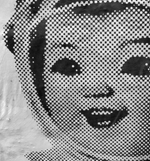Jonathan Hanahan is a creative technologist and educator who makes Thick Interfaces—tools, devices, software, artifacts, websites, and videos—that speculatively explore the physical, cultural, and social ramifications of the role technology plays in shaping our everyday realities. In his video piece Edgelands (2020), Hanahan juxtaposes distorted, AI-created images depicting midwestern landscapes combined with illegal e-waste dumpsites in Africa, Asia, and India, creating hypothetical landscapes which depict a potential future where the world is overrun by the West’s over-consumption of hardware.
:::
DigA: There’s a strange irony in making digital art about e-waste, which relies on hardware that will most certainly end up in a landfill. How do you work with or reconcile this irony in your work?
JH: I’m happy that you acknowledge this irony too. It’s something I wrestle with constantly in my work, and my answer to your question is twofold: first about my process and then in relation to this content.
I absolutely love the internet, but it also terrifies me. This is the reason I am driven to use new technology to investigate it. Embedding these tools in my process affords me the opportunity to understand them. Having been trained as a designer, I realized that a large part of design practice is to hide the complexity of systems. In regard to technology, designers often propagate the myth that our devices are “magic”—that they are just pictures under glass. But what happens underneath our screens is messy, deep, and complicated. Many of the subconscious behaviors that attend our participation in technology have long and lasting consequences. We can see the results of this all around us: fake news, data mining, surveillance, growing partisanship, and so on.
I am interested in using that same design process not to frost over the messiness, but rather to create opportunities for my audiences (and myself) to reevaluate our relationships with technology. My work isn’t about saying technology is bad or encouraging some mass unplugging. It is about encouraging people to be critical and aware of the decisions they make and the actions they take, often presenting a scenario or result that individuals can approach and evaluate on their own terms. I call these types of work Thick Interfaces. Thick Interfaces are experiences that temporarily disrupt or slow down familiar interactions with technology. They are ruptures to often-overlooked experiences as a means to momentarily reconsider and reimagine our behaviors.
My process is often to marry the right tool with the subject. A significant amount of my research is simply finding the right pairing of the two. In Edgelands, for instance, I spent the better part of a year experimenting with different methods: playing with actual e-waste, building things out of discarded products. But that process gave me too much control over the form. I could change it to whatever I saw fit. I prefer instead to let the tool or technology do the talking. I see my role more as a choreographer or director. I take a very procedural approach, meaning that 99% of the work comes from setting up the right scenario and then letting it run. I prefer to let the artifacts I produce be a result of that process with little to no abstraction or manipulation on my part. These are akin to data visualizations, in a way, although these are more qualitative rather than quantitative visualizations. I don’t want to say “This is bad” or “This is good” or “You should think this.” Rather I want to say, “This is it.” I want to call attention to what we don’t see or are disincentivized from seeing.
In regard to Edgelands, my hope is that it sheds light on the growing environmental crisis led by the ramifications of Western society’s capitalist/consumerist desire for the newest and best devices. E-waste is the fastest growing waste stream on the planet, and while new devices are increasingly made with recyclable materials, the processes used to make these devices lighter and smaller leads to manufacturing techniques that largely render those recycling capabilities null. These discarded products largely end up in illegal e-waste dumps in Africa, India, and Asia. While images of these places are alarming, I wanted to speculate on what it would feel like if our discarded electronics were no longer just out of sight and mind but began creeping into the periphery of everyday life and occupying our familiar and everyday environments
DigA: Edgelands is [has a] complex video piece that features various depictions of the natural world that seem to morph into the last image. What’s the significance of the movement of the piece?
JH: This component of Edgelands speaks a lot to the process-driven approach that I just described. This video is typically called a “Latent Space Walk”] and represents the training process of a Style Generative Adversarial Network (StyleGAN). This is the type of machine learning model I am using in this work to generate images. The StyleGAN is learning to make connections between disparate patterns in images. It is interpolating the “latent” space from one image in the dataset to another. This video represents that transition by rendering the intermediary latent points, something that usually goes unseen in the training process.
DigA: Continuing with Edgelands, can you give us any insight into the process of creating the piece?
The process of working with machine learning is largely about building a robust and reliable dataset. In this particular instance, I needed a dataset of images from which to teach the StyleGAN to generate similar images. Training a neural network is a bit like teaching a child to speak. Before we start, the child doesn’t know any language. If we only speak only English it will only learn English; if we speak English and French, the child will likely speak both. But if we don’t tell the child that English and French are different, it will speak a hybridized version of the two. I am using a similar process here. Typically we would feed a StyleGAN a single dataset of similar objects. For example, StyleGANs have been used to generate fake faces by learning from thousands of images of real faces. Because these dataset images are so similar, it can generate alarmingly accurate results from what it learned.
JH: For Edgelands I took the English/French route. I created a dataset of two types of images that shared similar characteristics: images of the American landscape, particularly around St. Louis made by a collaborating artist Jennifer Colton, and images from illegal e-waste dumpsites collected from Flickr and other image repositories. Currently, there are the themes—Horizons and Mounds—but I am currently working on several others. I categorized the datasets based on these themes and then fed them into the StyleGAN as if they were the same thing. The training processes subsequently “breed” these two types of images to create outputs that are a hybrid of both. This was again an attempt to blur the line between foreign and familiar. There are things in them that are incredibly alien but other things that are alarmingly friendly. They evoke for me an uncanny reaction akin to a kind of déjà vu. If other viewers experience this reaction as well, I hope that encourages them to further contemplate issues related to e-waste.
DigA: The 45th City investigates the role that design plays in the current epidemic of fake news, epitomized by the election of our 45th President. How do you think The 45th City relates to the current political climate where most right-wing news sources can land an interview with a conservative politician or figure?
JH: This question brings me almost full circle considering that I am responding to it on the day Joe Biden was announced as the 46th president. The 45th City project actually began in the days after Donald Trump’s election. I was feeling pretty defeated, and everything I was working on at the moment felt inconsequential. For a while I had been playing with this WebGL tool called Tilt3d—which extrudes the architecture of a website into a three-dimensional form—but I never had a strong reason to use it for anything. That was until I began looking at fake news websites with it and seeing just how bombastic the results were.
I will say that these patterns have a lot to do with the outlets by which audiences receive them. One of my main arguments in this work is that fake news isn’t a content problem but a design problem. Fake news has always existed—the difference now is that good design is subsequently flattening all information to look the same, making reliable and unreliable information indistinguishable from each other. In the past a politician would likely never want to be quoted or featured in the National Inquirer next to stories about alien abductions and three-headed babies. But contemporary fake news relies on walled garden–style platforms like Facebook and Twitter—which scrape content from sites and restyle them in their own approved design system—to mask their clumsy site architectures. They become difficult to distinguish because the presentation “looks” trustworthy. Therefore a politician may not care who they give their message to because the audience will almost always receive it filtered through one of these platforms.
The 45th City was never an attempt to be a “fake news detector.” This project was an opportunity to take audiences to the actual sources and sites outside of our walled gardens (without filling their own computers with viruses and clickbait) and allow them to see the mess that these illegitimate stories come from. This doesn’t mean that some reliable sites argent poorly built, or that some fake ones are not elegantly built. It does mean, however, that we need to remain vigilant in how we consume information and be reminded that there is clutter underneath our feeds that doesn’t just go away when its packaged in a comfortable aesthetic.
DigA: Nesting Dolls II explores digital content as a physical material. The installation features websites and subsequent physical artifacts that are crafted under the consideration that digital content has mass, depth, texture, and other physical characteristics. When you created Nesting Dolls II, what inspired you to explore the materiality of digital culture?
JH: Where The 45th City was about visualizing existing sites in 3D, Nesting Dolls was about creating them with their physical form as the guiding principle. I have a background in architecture and so I am always fascinated with physical space. Much of my work is about the pursuit of occupying the internet in a physical sense. I had this naive desire in my head that I wanted to create perfect translations of digital artifacts to physical ones. What I quickly learned was just how impossible that was. As part of the installation, I created a process video, a two-up view of the site being constructed onscreen alongside me physically constructing it in the studio. The website takes about six minutes to build. The sculpture took about two months, and it was far from perfect. To me, this represents the false sense of security we can get lulled into in the digital world. It’s easy to make things that feel solid, real, and trustworthy that are actually held together with toothpicks and chewing gum. Bringing things back to physical reality asks us to slow down and reveals the problems or underlying structural issues. This translation from digital to physical is pretty foundational to my notion of Thick Interfaces.
DigA: Can you talk a bit about your current projects?
JH: I am continuing to work on Edgelands, and I have a few upcoming shows of this work; an online show at the Gray Area Foundation for the Arts in San Francisco, and an in-person show at the Texas State Galleries at Texas State University. I am working on layering in some multisensory collaborations with writers and artists to further extract the narratives of discarded objects into speculative images of the familiar. I am also working on a dataset for an object detection algorithm that will hopefully discover objects in the images of Edgelands. I hope to be able to identify the discarded e-waste (computers, keyboards, bundles of wires, etc.) from the original datasets in these generated images.
Check out Jonathan Hanahan’s Edgelands.
:::

Jonathan Hanahan is a creative technologist and educator who makes Thick Interfaces—tools, devices, software, artifacts, websites, and videos—that speculatively explore the physical, cultural, and social ramifications of the role technology plays in shaping our everyday realities. In addition to his studio practice, Hanahan is an Assistant Professor in the Sam Fox School of Design & Visual Arts at Washington University in St. Louis where he teaches creative coding, procedural process, and interaction design. His recent work The 45th City—which explores ways of representing and occupying online news platforms in real space by making physical the original source code of fake news websites—was recently exhibited at the Pinkcomma Gallery in Boston, MA and The Luminary in St. Louis, MO.



